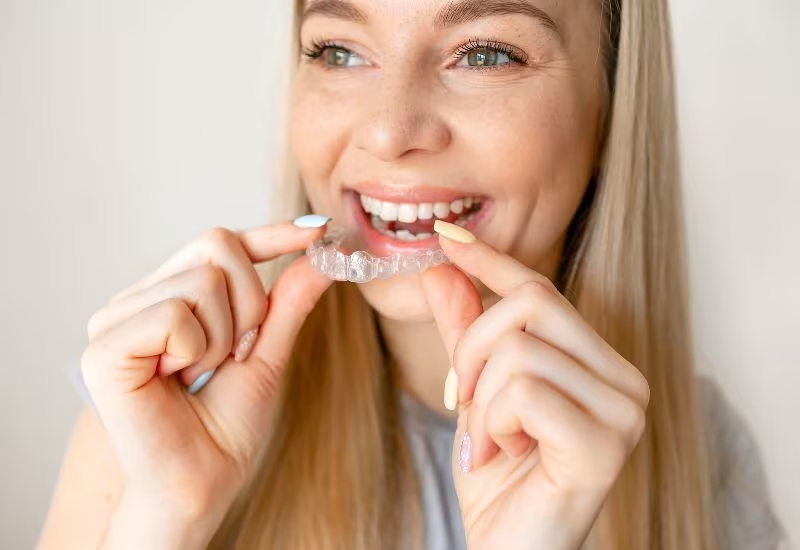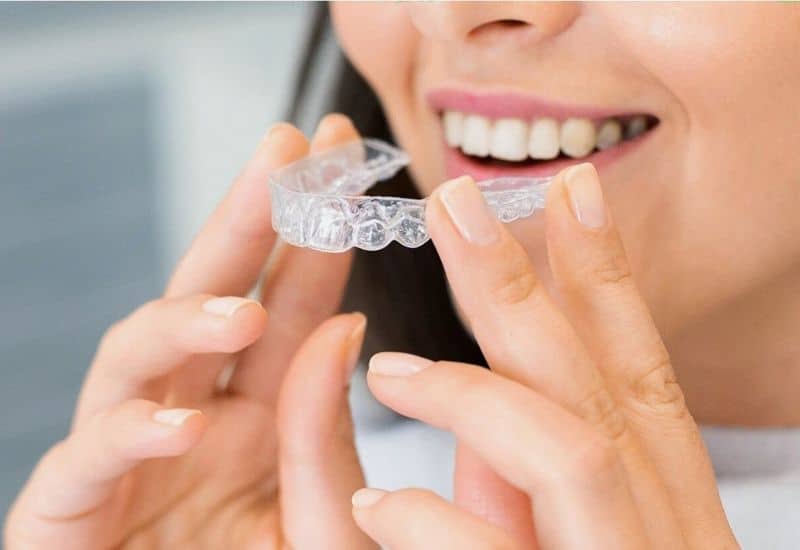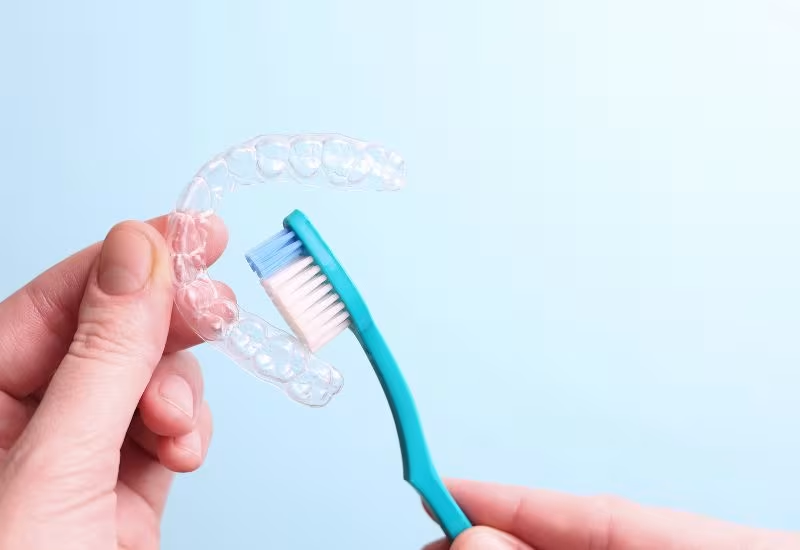Home / Dental Services / Invisalign
Invisalign Miami, FL
Orthodontics is vital for healthy teeth and jawbone development. Invisalign, the leading orthodontic solution, uses clear aligners to effectively and safely straighten teeth over time. At Gallardo Periodontics & Implant Dentistry, we offer Invisalign treatment, delivering exceptional results. Discover how this innovative method works for you.
Dr. Gallardo, Your Best Choice for Invisalign in Miami
- Nearly Invisible – Invisalign aligners are clear and discreet, so no one will notice you're straightening your teeth.
- Removable – Take them out to eat, drink, brush, and floss. No food restrictions.
- Comfortable – Smooth, custom-fit aligners without the irritation of metal braces.
- Easy Oral Care – Remove them for easy brushing and flossing, reducing the risk of cavities.
- No Diet Restrictions – Eat what you want, anytime, by removing the aligners.
- Proven Results – Effective for many orthodontic issues, enhanced by Dr. Gallardo’s expertise.
What is Invisalign?
Invisalign (clear aligners) is an excellent alternative to traditional metal braces. Named for the clear or “invisible” aligners that are used for orthodontic correction, Invisalign can straighten a patient’s crooked teeth in less time and is less noticeable than the metal bracket and wire system. Unlike braces, clear aligners can be removed for eating and drinking and do not restrict the foods that patients can enjoy.
As a periodontics specialist, Dr. Gallardo recommends Invisalign for many reasons, including their ability to help patients with gum issues. Patients are better able to care for their oral health with the removable trays and can more easily maintain the reversal of their gum disease by using clear aligners vs. braces. Additionally, the Invisalign trays are situated above the gum line and will not trap food and bacteria between the teeth and gums.

Why Choose Invisalign Over Traditional Braces
Invisalign clear aligners offer several advantages over traditional braces. They require fewer office visits, making them a more convenient option for busy individuals.
Being virtually invisible, Invisalign allows patients to undergo orthodontic treatment discreetly. They can also be easily removed for eating and cleaning, eliminating the dietary restrictions associated with traditional braces. Additionally, Invisalign is typically less costly than traditional braces, making it a more affordable choice for many patients.

Best Candidates for Invisalign in Miami, FL
Invisalign is a versatile treatment option that can cater to a wide range of orthodontic issues. It’s an ideal choice for individuals who wish to:
- Correct misaligned teeth or close gaps.
- Rectify overbites and underbites.
- Comply by wearing the aligners for 20-22 hours a day.
- Have a convenient orthodontic solution that doesn’t interfere with their lifestyle.
Dr. Gallardo, with his vast experience and knowledge, is adept at determining whether Invisalign is the right treatment for his patients in Miami, FL.
What Our Patients Say
Committed to your results
Invisalign at Gallardo Periodontics
The journey to a straighter smile at Gallardo Periodontics and Implant Dentistry includes:
Step 1
Initial Consultation
Meet with Dr. Gallardo for a comprehensive examination of your teeth and oral health, and discuss your dental goals and expectations.
Step 2
Personalized Treatment Plan
Creation of a tailored plan based on your specific dental needs.
Step 3
Advanced Digital Imaging
Utilization of digital technology to capture a 3D image of your teeth, essential for designing your custom Invisalign aligners.
Step 4
Custom-Made Invisalign Aligners
Development of a series of aligners to gradually adjust your teeth to the desired position.
Step 5
Treatment Duration and Process
Dr. Gallardo will provide an estimated timeline for your treatment and address any questions regarding the Invisalign procedure. On average you will transition to a new set of aligners every 1-2 weeks, gradually moving teeth into alignment.
Cost of Invisalign in Miami, FL
Invisalign treatment costs in Miami vary based on factors like your specific dental issues, length of treatment, and insurance coverage. Although Invisalign is typically more expensive than traditional braces, it provides a level of convenience, comfort, and discretion that traditional braces can’t match. Additionally, the cost of Invisalign includes all necessary follow-up appointments, making it a comprehensive orthodontic solution.
During your consultation with Dr. Gallardo, he will provide a detailed estimate of the total cost of your Invisalign treatment. It’s worth noting that many dental insurance plans cover a portion of the cost of Invisalign, and financing options are also available to make the treatment more affordable.
Wilckodontics (PAOO) and Invisalign
Wilckodontics, or periodontally accelerated osteogenic orthodontics (PAOO), involves combining orthodontic and periodontal procedures to achieve optimal orthodontic results. The most noteworthy benefit of Wilckodontics is that it can prevent periodontal problems by creating sufficient bone in areas where it is typically lacking. The jawbones are demineralized during the procedure, and some bone is either etched away or removed to speed up the movement of the teeth. New bone forms in its place, resulting in a stronger base for the teeth.
Other benefits include a quicker orthodontic treatment, more bone to support teeth in the long run, reduced loss of gum tissue, less root resorption, and lower chances of relapse. Wilckodontics can be paired with Invisalign to move teeth without the need for wires and brackets. This contemporary orthodontic treatment can lead to improved oral health.
Wear Your Invisalign Trays for 20-22 Hours a Day
To ensure Invisalign success, it's essential to wear the aligners for 20-22 hours per day minimum. This allows the aligners to effectively shift your teeth into their desired positions.
Invisalign Aftercare and Maintenance
Once your teeth have reached their ideal position, Dr. Gallardo will provide you with a retainer to maintain your new, straight smile. Wearing your retainer as instructed is crucial to prevent your teeth from shifting back to their original position, ensuring long-lasting results.
Quick Aftercare Tips:
- Clean your retainer daily with a toothbrush and mild soap.
- Store it properly in a protective case when not in use.
- Maintain good oral hygiene by brushing and flossing regularly.
- Attend regular dental check-ups to monitor your alignment.
- Avoid biting hard foods like ice or nuts to protect your teeth.


Why Choose Dr. Gallardo for Your Invisalign
Dr. John Paul Gallardo at Gallardo Periodontics and Implant Dentistry in Miami, FL, has 30 years of experience in the field. Some reasons to choose Dr. Gallardo for your Invisalign treatment include:
- Extensive experience and expertise in the fields of periodontics and implant dentistry.
- Sought by patients from all over the world.
- State-of-the-art facility offering safe and effective treatments.
- Personalized treatment plans tailored to each patient’s unique needs.
- One of the few providers of IV conscious sedation in South Florida
Invisalign requires a highly skilled dental expert like Dr. Gallardo to make sure you receive the best orthodontic treatment and outcome.
Frequently Asked Questions About Invisalign
Is wearing braces the preferred method of correction for misaligned teeth?
With more teeth straightening options available than ever before, prospective patients should meet with South Florida periodontist Dr. Gallardo to discuss aligners vs. braces. In more complicated cases, metal braces may be the preferred option. Sometimes, metal braces can be switched for clear aligners after some progress with tooth alignment is made.
With other methods available, why choose Invisalign?
Some patients want to know the difference between other clear braces vs. Invisalign as new products enter the market. Invisalign invisible trays are sturdier than other clear aligners and offer a compliance-tracking system so parents know their teenagers are wearing the trays as prescribed. Invisalign is also supported by two decades of research. When it comes to clear or ceramic braces as an Invisalign alternative, traditional metal brackets can be replaced by a clear material and a white wire replaces the silver-colored metal. The system is still visible and can become stained by foods and beverages because they are not removable, like Invisalign. Patients will have to use special brushing and flossing techniques, hardware may become loose, and certain discomforts will exist. Wearing aligners vs. braces will prevent common and unwanted side effects.
Will Invisalign fix an overbite?
Invisalign is an effective treatment option for correcting overbites in many cases. However, the success of the treatment depends on the severity of the overbite and the expertise of the provider. Dr. Gallardo will evaluate your specific case and determine if Invisalign is the best option for addressing your overbite.
Can Invisalign fix gaps?
Yes, Invisalign is an excellent solution for closing gaps between teeth. The clear aligners gradually shift the teeth into their desired positions, effectively closing gaps and improving the overall appearance of your smile.
Can Invisalign fix crowding?
Invisalign can effectively treat mild-to-moderate crowding issues. Dr. Gallardo will assess your specific condition during the consultation and determine if Invisalign is the best treatment option for addressing your crowding concerns.
How long does Invisalign take?
Invisalign treatment times can vary from one patient to the next because each case is unique. Factors like tooth structure, age, and patient compliance can affect treatment time. In most cases, Invisalign treatment can be completed in one to two years, though in minor cases, achieving a straight smile may take only months. Invisalign before and after photos are sometimes labeled with treatment time to better illustrate timeframes for interested patients.
How much does Invisalign cost? How much do clear braces cost?
In most cases, Invisalign costs more than traditional braces, but about the same as clear braces. Dr. Gallardo will assess the corrections needed and front office staff can work with patients and their dental plans to determine the cost of Invisalign and how much of the clear braces’ cost their treatment plan cover.
How much does Invisalign cost for top teeth only? What about bottom teeth straightening?
A consultation with Dr. Gallardo will conclude with an estimate for the invisible aligners at his Coral Gables office and can be specific to the cost for top or bottom row correction.
Can clear aligners permanently straighten my teeth?
When wearing the clear aligners at home as prescribed by Dr. Gallardo, patients can achieve a beautiful smile with lasting results, so long as they follow-up care with a retainer. These metal wires can be installed behind the teeth so that they are undetectable.
Some wires are patterned so they will not impede regular dental flossing. The clear aligners’ before and after results may not be as dramatic if the teeth are allowed to shift back into their original position.
Why are invisible aligners a good solution for patients with gum disease and crooked teeth?
Dr. Gallardo may recommend that periodontal patients with crooked teeth wear clear aligners at home because they can maintain their oral hygiene more easily through the Invisalign system. Gum disease occurs when bacteria accumulate between the teeth and gums.
What Invisalign office is near me?
If you live near Miami, FL, Gallardo Periodontics and Implant Dentistry offers Invisalign among its services, and is conveniently located at 2020 SW 27th Ave Miami, FL 33145